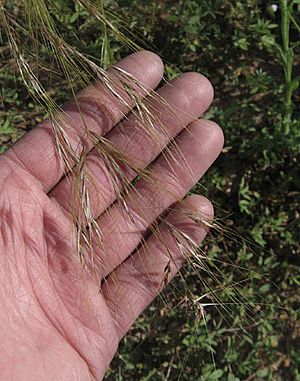Purple needlegrass facts for kids
Quick facts for kids Purple needlegrass |
|
|---|---|
 |
|
| Conservation status | |
| Scientific classification | |
| Genus: |
Nassella
|
| Species: |
pulchra
|
| Synonyms | |
|
|
Purple needlegrass (its scientific name is Nassella pulchra) is a type of grass. People also call it purple tussockgrass. This special grass grows naturally in California, a state in the United States. You can find it all over California's coastal hills, valleys, and mountains. It also grows in the Sacramento Valley and parts of the Sierra Nevada foothills. You can even find it south of the border in Baja California, Mexico.
Purple needlegrass likes to grow in many different places. These include grasslands, chaparral, and oak woodlands. It grows especially well in clay and serpentine soils.
Contents
What is Purple Needlegrass?
Purple needlegrass is a bunch grass. This means it grows in clumps or tufts. It has straight stems that can grow up to 1 metre (3.3 ft) tall. Its roots are very long, reaching up to 20 feet (6.1 m) deep into the soil. These deep roots help the grass survive when there isn't much rain. This makes it very good at handling drought.
The plant has an open, nodding inflorescence. This is the part of the plant that holds the flowers and seeds. It can be up to 60 centimeters long. It has many branches that hold the small flowers, called spikelets.
Purple needlegrass makes a lot of seeds. A dense area of this grass can produce up to 227 pounds of seeds per acre. The seeds are pointed and look a bit purple when they are young. Each seed has a long, twisted part called an awn. This awn can be up to 10 centimeters long. The special shape of the seed helps it bury itself in the ground.
Cool Uses for This Grass
This grass is very important to California's Native American groups. They use purple needlegrass to teach the art of basket weaving. It is their favorite material for making beautiful baskets.
California's Official Grass
In 2004, purple needlegrass became the official state grass of California. It is a symbol of the state for a few reasons. Many people see it as one of the most common native grasses in California. It also supported both Native American groups and Mexican ranchers in the past. Today, it helps stop invasive plant species from taking over. It also helps support native oak trees.
Home for Wildlife
Purple needlegrass is good for nature. Besides helping native oak trees, it also provides a home and food for some butterflies. Caterpillars of the common branded skipper and Uncas skipper butterflies eat this grass.


